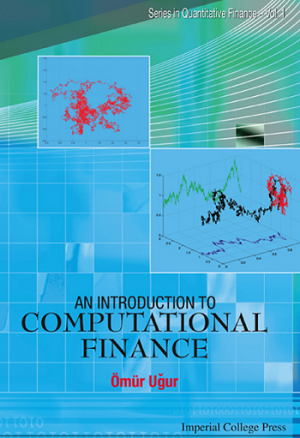Ömür Uğur, An Introduction to Computational Finance, Imperial College Press, 2009 (December 2008).
- Front Matter (Preface, Acknowledgments and Contents) [PDF/EPUB]
- Chapter 4: The Black-Scholes Equation [PDF/EPUB]
- Back Matter (Appendix: A Short Introduction to MATLAB and Bibliography) [PDF/EPUB]
- Errata (Sorry for the inconvenience!)
About the Book
Although there are several publications on similar subjects, this book mainly focuses on pricing of options and bridges the gap between Mathematical Finance and Numerical Methodologies. The author collects the key contributions of several monographs and selected literature, values and displays their importance, and composes them here to create a work which has its own characteristics in content and style.
This invaluable book provides working MATLAB codes not only to implement the algorithms presented in the text, but also to help readers code their own pricing algorithms in their preferred programming languages. Availability of the codes under an Internet site is also offered by the author.
Not only does this book serve as a textbook in related undergraduate or graduate courses, but it can also be used by those who wish to implement or learn pricing algorithms by themselves. The basic methods of option pricing are presented in a self-contained and unified manner, and will hopefully help readers improve their mathematical and computational backgrounds for more advanced topics.
Contents
- Front Matter (Preface, Acknowledgments and Contents) [PDF/EPUB]
- Chapter 1: Introduction (includes Fixed-Income Securities and Portfolio Optimisation)
- Chapter 2: Option Pricing and Binomial Methods
- Chapter 3: Stochastic Differential Equations
- Chapter 4: The Black-Scholes Equation (Sample Chapter) [PDF/EPUB]
- Chapter 5: Random Numbers and Monte Carlo Simulation
- Chapter 6: Option Pricing by Partial Differential Equations
- Back Matter (Appendix: A Short Introduction to MATLAB and Bibliography) [PDF/EPUB]
- Errata (Sorry for the inconvenience!)
Readership: Graduates and undergraduate students in mathematics, finance, and related applied sciences; practitioners and non-experts in business and financial sectors; academics for their courses in option pricing.
Knowing that the learning process never ends, any suggestions, comments and corrections are welcome and very much appreciated. I am looking forward to hearing from you.
Sincere Regards,
Ömür Uğur
Author
